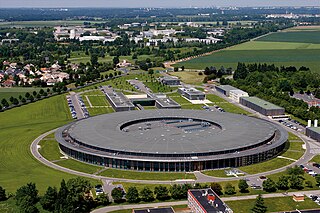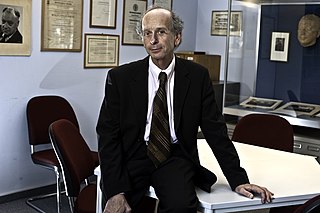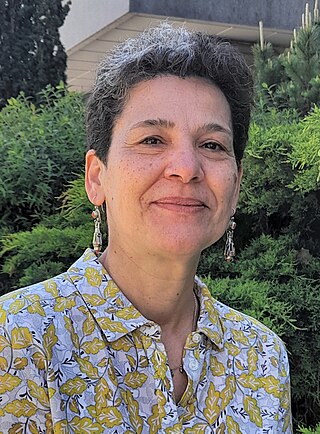Related Research Articles

The French Alternative Energies and Atomic Energy Commission, or CEA, is a French public government-funded research organisation in the areas of energy, defense and security, information technologies and health technologies. The CEA maintains a cross-disciplinary culture of engineers and researchers, building on the synergies between fundamental and technological research.

The Underground Area 2 (UA2) experiment was a high-energy physics experiment at the Proton-Antiproton Collider — a modification of the Super Proton Synchrotron (SPS) — at CERN. The experiment ran from 1981 until 1990, and its main objective was to discover the W and Z bosons. UA2, together with the UA1 experiment, succeeded in discovering these particles in 1983, leading to the 1984 Nobel Prize in Physics being awarded to Carlo Rubbia and Simon van der Meer. The UA2 experiment also observed the first evidence for jet production in hadron collisions in 1981, and was involved in the searches of the top quark and of supersymmetric particles. Pierre Darriulat was the spokesperson of UA2 from 1981 to 1986, followed by Luigi Di Lella from 1986 to 1990.

SOLEIL is a synchrotron facility near Paris, France. It performed its first acceleration of electrons on May 14, 2006. The name SOLEIL is a backronym for Source optimisée de lumière d’énergie intermédiaire du LURE, LURE meaning Laboratoire pour l'utilisation du rayonnement électromagnétique.
The Grand Accélérateur National d'Ions Lourds (GANIL), or Large Heavy Ion National Accelerator, is a French national nuclear physics research center in Caen. The facility has been in operation since 1983, and consists primarily of two serialised synchrocyclotrons. It is a part of the French Alternative Energies and Atomic Energy Commission (CEA), more specifically the CEA Paris-Saclay center.

Stavros Katsanevas was a Greek-French astrophysicist who was director of the European Gravitational Observatory, professor at the Université Paris Cité, former director of the AstroParticle and Cosmology (APC) laboratory and former chairman of the Astroparticle Physics European Consortium (APPEC). In 2000, he received for his work on supersymmetry the Physics Prize from the Academy of Athens. In 2011, he was awarded the Ordre National du Merite. He was an ordinary member of Academy of Europe, Earth and Cosmic Sciences since 2019.
Raymond Félix Stora was a French theoretical physicist. He was a researcher at Service de Physique Théorique at CEA Saclay, then a research director at the French National Centre for Scientific Research (CNRS) at CPT Marseille and at LAPP Annecy, as well as a member of CERN's theory group. His work focused on particle physics.

Peter Jenni, is an experimental particle physicist working at CERN. He is best known as one of the "founding fathers" of the ATLAS experiment at the CERN Large Hadron Collider together with a few other colleagues. He acted as spokesperson of the ATLAS Collaboration until 2009. ATLAS is a world-wide collaboration which started in 1992 involving roughly 3,000 physicists at 183 institutions in 38 countries. Jenni was directly involved in the experimental work leading to the discoveries of the W and Z bosons in the 1980s and the Higgs boson in 2012. He is (co-)author of about 1000 publications in scientific journals.

The Astroparticle and Cosmology (APC) laboratory in Paris gathers researchers working in different areas including high-energy astrophysics, cosmology, gravitation, and neutrino physics.

Paris-Saclay University is a combined technological research institute and public research university in Paris, France. Paris-Saclay was established in 2019 after the merger of four technical grandes écoles, as well as several technological institutes, engineering schools, and research facilities; giving it fifteen constituent colleges with over 48,000 students combined.

The 81 cm Saclay Bubble Chamber was a liquid hydrogen bubble chamber built at Saclay, in collaboration with the École Polytechnique (Orsay), to study particle physics. The team led by Bernard Gregory completed the construction of the chamber in 1960 and later it was moved to CERN and installed at the Proton Synchrotron (PS).

Pierre Darriulat is a French experimental particle physicist. As staff member at CERN, he contributed in several prestigious experiments. He was the spokesperson of the UA2 collaboration from 1981 to 1986, during which time the UA2 collaboration, together with the UA1 collaboration, discovered the W and Z bosons in 1983.

]

Michel Spiro is a French physicist.
Natalie Ann Roe is an experimental particle physicist and observational cosmologist, and the Associate Laboratory Director for the Physical Sciences Area at Lawrence Berkeley National Laboratory (LBNL) since 2020. Previously, she was the Physics Division Director for eight years. She has been awarded as the Fellow of American Physical Society (APS) and American Association for the Advancement of Science (AAAS) for her exceptional scientific career and contributions.
Daniel Pomarède is a staff scientist at the Institute of Research into the Fundamental Laws of the Universe, CEA Paris-Saclay University. He co-discovered Laniakea, our home supercluster of galaxies, and Ho'oleilana, a spherical shell-like structure 1 billion light-years in diameter found in the distribution of galaxies, possibly the remnant of a Baryon Acoustic Oscillation. Specialized in data visualization and cosmography, a branch of cosmology dedicated to mapping the Universe, he also co-authored the discoveries of the Dipole Repeller and of the Cold Spot Repeller, two large influential cosmic voids, and the discovery of the South Pole Wall, a large-scale structure located in the direction of the south celestial pole beyond the southern frontiers of Laniakea.
Shirley Ho is an American astrophysicist and machine learning expert, currently at the Center for Computational Astrophysics at Flatiron Institute in NYC and at the New York University and the Carnegie Mellon University. Ho also has visiting appointment at Princeton University.

Nathalie Palanque-Delabrouille,, is a French cosmologist. During her career as a researcher in particle physics, she has taken part in several large-scale experiments. Her work has been recognized several times including the Irène Joliot-Curie Prize, the appointment as Knight of the Legion of Honor and her election to the French Academy of Sciences.

Faïrouz Malek also known as Faïrouz Ohlsson-Malek is a French and Algerian physicist specializing in nuclear physics, particle physics and cosmology. A research scientist at the French National Centre for Scientific Research, she is involved in international research at the CERN LHC. She has contributed to the discovery of the Higgs boson. She is also known for her commitment to gender parity in science, as well as to the development of science in Africa. She is fellow of the African Academy of Sciences. She is the niece of Algerian composer Ahmed Malek.
Cristina Toninelli is an Italian mathematician who works in France as a director of research for the French National Centre for Scientific Research (CNRS), at the Centre de recherche en mathématiques de la décision (Ceremade) of Paris Dauphine University. Her research concerns the probability theory and statistical mechanics of phase transitions in interacting particle systems, including bootstrap percolation, glass transitions, and jamming. She has also studied cellular automata and group testing.
The Institute of Theoretical Physics (IPhT) is a research institute of the Direction of Fundamental Research (DRF) of the French Alternative Energies and Atomic Energy Commission (CEA). The Institute is also a joint research unit of the Institute of Physics (INP), a subsidiary of the French National Center for Scientific Research (CNRS). It is associated to the Paris-Saclay University. IPhT is situated on the Saclay Plateau South of Paris.
References
- ↑ Birth year from VIAF authority control record, retrieved 2023-03-13
- 1 2 Dr. Vanina Ruhlmann-Kleider, École de Physique des Houches, March 2011, retrieved 2023-03-13
- 1 2 3 "Vanina Ruhlmann-Kleider", Les médailles d'argent (PDF) (in French), CNRS, 2003, p. 27, retrieved 2023-03-13
- ↑ Ruhlmann, Vanina (1988), Mesure de constant de couplage effective de l'interaction forte déduite de l'étude des processus de productions des bosons W et Z (expérience UA2) [Measurement of the strong running coupling constant from W and Z production (UA2 experiment)](PDF) (in French), CEA Paris-Saclay, retrieved 2023-03-13– via CERN
- ↑ "Vanina Ruhlmann-Kleider INSPIRE author profile". inspirehep.net. Retrieved 2024-02-26.
- ↑ New breakthrough towards understanding dark energy, Chinese Academy of Sciences, 1 May 2021, retrieved 2023-03-13– via SciTechDaily
- ↑ Cosmology, CEA IRFU, retrieved 2023-03-13
- ↑ "Décret du 31 décembre 2010 portant promotion et nomination", Journal Officiel, retrieved 2023-03-13